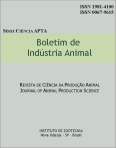Reproductive efficiency of Nelore heifers born from two different breeding seasons
Abstract
The work was carried out at the Estação Experimental de Zootecnia, Sertãozinho São Paulo State, Brazil. The main objective was to estimate the influence of two breeding seasons, April to August (treatment A) and October to February (treatment B), on: 1 - calving frequency along the year; 2 - reproductive efficiency up to the 3rd calving; 3 - liveweight changes of the cow during the lactating period; and 4 - liveweight of calves at 1, 120 and 210 days of age. The months of highest calving rates wee March (48.3%) and August (37.9%) for breeding seasons A and B, respectively. Calving percentages were the same for both breeding season at the first and third calving, but higher for treatment B than for treatment A (72.9 and 45.8%, respectively) at the second calving. Cows on treatment A lost and on treatment B gained weight during the nursing period. Calves from treatment B were heavier than the ones from treatment A at weaning.Downloads
Downloads
Published
Issue
Section
License
Os autores não serão remunerados pela publicação de trabalhos, pois devem abrir mão de seus direitos autorais em favor deste periódico. Por outro lado, os autores ficam autorizados a publicar seus artigos, simultaneamente, em repositórios da instituição de sua origem, desde que citada a fonte da publicação original seja Boletim de Indústria Animal. A revista se reserva o direito de efetuar, nos originais, alterações de ordem normativa, ortográfica e gramatical, com vistas a manter o padrão culto da língua e a credibilidade do veículo. Respeitará, no entanto, o estilo de escrever dos autores. Alterações, correções ou sugestões de ordem conceitual serão encaminhadas aos autores, quando necessário. Nesses casos, os artigos, depois de adequados, deverão ser submetidos a nova apreciação. As opiniões emitidas pelos autores dos artigos são de sua exclusiva responsabilidade. Todo o conteúdo deste periódico, exceto onde está identificado, está licenciado sob a Licença Creative Commons Attribution (CC-BY-NC). A condição BY implica que os licenciados podem copiar, distribuir, exibir e executar a obra e fazer trabalhos derivados com base em que só se dão o autor ou licenciante os créditos na forma especificada por estes. A cláusula NC significa que os licenciados podem copiar, distribuir, exibir e executar a obra e fazer trabalhos derivados com base apenas para fins não comerciais.













